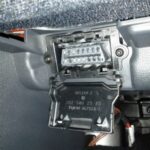Clearing your car’s check engine light can sometimes feel like solving a mystery. When that light pops on, your car’s onboard diagnostic system, or OBD2, has detected an issue. One common question among car owners is whether disconnecting the battery can erase these OBD2 codes. Let’s dive into this DIY method and explore if it’s a viable solution for your car.
Does Disconnecting Your Car Battery Erase OBD2 Codes?
Yes, disconnecting your car battery can erase OBD2 codes and reset the check engine light. When you disconnect the battery, you cut off power to the car’s computer, including the memory that stores diagnostic trouble codes. This is similar to rebooting your home computer; it can clear temporary glitches and reset systems.
However, it’s crucial to understand that this method is essentially a temporary fix. While disconnecting the battery might turn off the light, it doesn’t actually repair the underlying problem that triggered the code in the first place.
How to Disconnect Your Battery to (Potentially) Erase OBD2 Codes
If you decide to try this method, follow these steps carefully to safely disconnect your car battery:
- Safety First: Wear safety glasses and gloves. Ensure your car is turned off and parked on a level surface.
- Locate the Battery: Typically under the hood, but sometimes in the trunk or under the back seat.
- Identify Terminals: Find the negative (-) and positive (+) terminals. The negative terminal is usually black and may have a (-) symbol.
- Disconnect Negative Terminal: Using a wrench, loosen the nut on the negative terminal clamp. Remove the negative cable and tuck it aside, ensuring it doesn’t accidentally touch the terminal.
- Disconnect Positive Terminal (Optional but Recommended): Repeat the process for the positive terminal (usually red and marked with a (+) symbol). This further ensures no stray current.
- Wait: Let your car sit for 15-30 minutes. This allows sufficient time for the computer’s memory to fully reset.
- Reconnect Positive Terminal (If Disconnected): Reattach the positive cable and tighten the nut.
- Reconnect Negative Terminal: Reattach the negative cable and tighten the nut securely.
- Start Your Car: Turn on your car and see if the check engine light is off.
Why Disconnecting the Battery Might Work (Temporarily)
Your car’s computer uses volatile memory to store OBD2 codes. Volatile memory requires constant power to retain data. Disconnecting the battery removes this power source, causing the volatile memory to lose its stored information, including the diagnostic codes and the check engine light status.
Limitations and Risks of Battery Disconnection
While disconnecting the battery is a simple DIY trick, it has significant limitations:
- Doesn’t Fix the Real Problem: It only masks the symptom. The underlying issue causing the OBD2 code remains and will likely trigger the check engine light again soon.
- Code May Return Quickly: If the problem is still present, the OBD2 system will quickly redetect it, and the check engine light will reappear, sometimes within minutes or days.
- Loss of Other Settings: Disconnecting the battery can also erase other volatile memory settings, such as radio presets, seat memory positions, and clock settings. You may need to reset these after reconnecting the battery.
- Potential for Electrical Issues (Rare): While generally safe, improper disconnection or reconnection could potentially cause minor electrical glitches in some vehicles.
A Better Alternative: Using an OBD2 Scanner
For a proper diagnosis and code clearing, using an OBD2 scanner is highly recommended. OBD2 scanners are affordable tools that plug into your car’s diagnostic port (usually under the dashboard). They allow you to:
- Read the Specific OBD2 Code: This tells you exactly what problem the car’s computer has detected (e.g., “P0420 Catalyst System Efficiency Below Threshold”).
- Understand the Issue: Knowing the code helps you research the potential cause and the severity of the problem.
- Clear Codes Properly: Scanners can clear codes directly from the computer’s memory in a controlled way.
- Monitor Car Performance: Some advanced scanners can provide real-time data about your car’s engine and systems.
Conclusion
Disconnecting the battery to erase OBD2 codes is a quick trick that might temporarily turn off the check engine light. However, it’s not a real solution for car problems. For proper diagnosis and long-term car health, investing in an OBD2 scanner and addressing the root cause of the issue is always the best approach. Ignoring a check engine light or simply resetting it without investigation can lead to more serious problems and costly repairs down the road.
